The importance of letting my teenage son with EB be ‘normal’
At 15, Jonah's not ready to connect with the EB community — and that's OK

Earlier this week, my son Jonah and I had a visit with his pain doctor, Dr. Savi. She is the coolest, even in the eyes of the ultimate coolness judge, a 15-year-old boy.
She oohs and aahs appropriately over Jonah’s growth. I tell her Jonah is now 5 feet, 2 inches tall, and Jonah corrects me by saying he’s 5 feet, 3 inches tall. Dr. Savi agrees with Jonah, as any cool doctor would, and congratulates him on his added inches and deepening voice.
Then she asks him, “Jonah, do you have any friends or people you are close to in the epidermolysis bullosa (EB) community?”
“No,” he replies. I let the silence sit a moment. Then I chime in.
When Jonah was younger, he didn’t mind so much that he was rare. He was blissfully, nonchalantly, just Jonah. And to him, that was good enough. He knew he had pain and extra challenges. But he shook his booty onstage at preschool choir like a boss and openly gave his testimony about EB.
During the seven years we held Jogging for Jonah, a race to raise money for research and advocacy, he was purely and proudly the poster child for this rare disease, and happy to raise awareness. Time after time, we made the trip to Colorado, Texas, Arizona, or Florida for the debra of America Care Conference, and he was excited about it. We met folks who were fighting our same battle, Jonah hung with kids who had boo-boos like him, and we learned from doctors who specialized in specific fields related to EB.
But now he doesn’t want to. At 15, more and more, he just wants to be normal.

Jonah Williams, then 3 years old, speaks at the first (of seven) Jogging for Jonah race event in 2012, with help from his mom, Patrice. She and others organized the race to raise money for a cure for EB and for patient and family advocacy. (Courtesy of Patrice Williams)
Letting Jonah be a typical teenager
I get it, man. Who wouldn’t want, at his age especially, to just be normal?
Of course, he knows he’s really not. He’s reminded daily as he endures wound care, tube feeding, and a baseline of constant pain. He recognizes his limitations. He watches sports from the stands at school or from the comfort of his own couch. Just watching. Never playing. And these days, those are the only reminders of his difference that he wants.
Jonah doesn’t want to be an advocate or a poster child at an event. He doesn’t want to host a race for research. And he doesn’t want to connect with others who have EB. It’s not bad or wrong, it just is. He wants to have his high school friends, his Wake Forest University experience (it’s worth EB awareness to hang with college basketball players; that’s a no-brainer), homework, a driver’s permit, and a school workload he can complain about — just like any normal 15-year-old. I don’t blame him.
I think one day he’ll want the knowledge, camaraderie, and connection of the EB community. One day I won’t be around to find answers to his questions. Or there will be questions he wants to seek answers to himself. Someday he’ll want to know and have a relationship with young adults who look like him and know the challenges he faces firsthand. He’ll need someone who says, “I get it,” and isn’t just blowing smoke. He’ll need someone who has a trick for quicker wound care or a remedy for itchy, healing skin. He’ll need someone who has overcome a similar obstacle and is succeeding. He’ll need someone who says, “Man, that sucks,” and knows that it really, really does.
But today, he just wants to be normal.
For now, it’s on me to seek the education, develop and maintain the relationships, advocate for his needs, raise the money, and go to the conferences. One day he’ll be ready and want to do it for himself. When that day comes, I’ll take my steps back and let him figure out how to walk the path with others living with EB. If he wants, I’ll help him find a balance between embracing fully who he is, living in community with those who are like him, and leading as normal a life as he can, while telling his disability to go shove it.
On that day, we’ll figure it out.
But right now, I’ll just let him be. I’ll let him be normal.
Note: Epidermolysis Bullosa News is strictly a news and information website about the disease. It does not provide medical advice, diagnosis, or treatment. This content is not intended to be a substitute for professional medical advice, diagnosis, or treatment. Always seek the advice of your physician or other qualified health provider with any questions you may have regarding a medical condition. Never disregard professional medical advice or delay in seeking it because of something you have read on this website. The opinions expressed in this column are not those of Epidermolysis Bullosa News or its parent company, Bionews, and are intended to spark discussion about issues pertaining to epidermolysis bullosa.








Leave a comment
Fill in the required fields to post. Your email address will not be published.